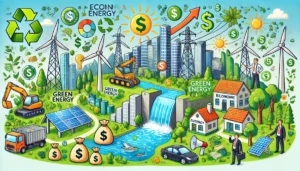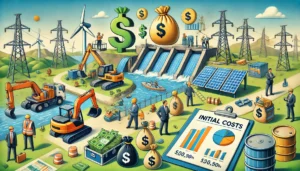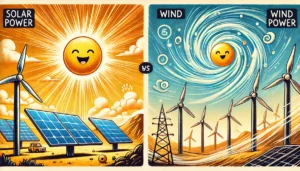Reading Practice for Intermediate: The Bright and Shadowy Sides of Green Energy
A. Building Knowledge of the Field
Have students watch the video below to build their knowledge on green energy!
Have students answer the questions below orally!
- What is green energy, and why is it important?
- Name at least two types of renewable energy sources mentioned in the video!
- What are some benefits of using green energy?
- What are some challenges associated with green energy?
- How can individuals contribute to the adoption of green energy in their daily lives according to the video?
B. Related/Technical Vocabulary
Have students learn the following green energy vocabulary to understand the upcoming text better. (Play the audio for each vocabulary word, have students repeat it, and then discuss the meaning together)
| 1 | Green energy | Energy derived from natural sources that are renewable and environmentally friendly, such as sunlight, wind, and water. | |
| 2 | Sunlight | The natural light emitted by the sun, used as a renewable energy source in solar power technologies. | |
| 3 | Wind | The natural movement of air, harnessed by wind turbines to generate electricity. | |
| 4 | Water | A natural resource used in hydroelectric power plants to generate energy through the movement of water. | |
| 5 | Climate change | Long-term changes in temperature and weather patterns, primarily due to human activities like burning fossil fuels. | |
| 6 | Fossil fuels | Natural fuels such as coal, oil, and natural gas formed from the remains of living organisms, which emit greenhouse gases when burned. | |
| 7 | Environmentally friendly | Having minimal impact on the environment; not causing harm to the ecosystem. | |
| 8 | Greenhouse gases | Gases such as carbon dioxide and methane that trap heat in the atmosphere, contributing to global warming. | |
| 9 | Pollution | The presence of harmful substances in the environment, often a byproduct of burning fossil fuels. | |
| 10 | Solar panels | Devices that convert sunlight into electricity, typically made of photovoltaic cells. | |
| 11 | Wind turbines | Machines that convert the kinetic energy of wind into mechanical power, which is then used to generate electricity. | |
| 12 | Hydroelectric plants | Facilities that generate electricity by using the energy of moving water. | |
| 13 | Clean energy | Energy that does not pollute the atmosphere when used, as opposed to fossil fuels. | |
| 14 | Carbon footprint | The total amount of greenhouse gases emitted by an individual, organization, event, or product. | |
| 15 | Renewable | A resource that can be replenished naturally over short periods of time, such as solar and wind energy. | |
| 16 | Energy independence | The ability of a country or region to produce its own energy without relying on imported fuels. | |
| 17 | Economic benefits | Financial advantages, such as job creation and economic growth, resulting from investments in green energy. | |
| 18 | Green energy sector | The industry involved in producing and managing renewable energy sources and technologies. | |
| 19 | Economic growth | An increase in the production of goods and services in an economy, often measured by GDP. | |
| 20 | Green energy infrastructure | The physical structures and facilities needed to produce, store, and distribute renewable energy, such as solar farms and wind turbines. | |
| 21 | Solar power | Energy from the sun that is converted into thermal or electrical energy. | |
| 22 | Energy supply | The total amount of energy available for use, which can come from various sources including fossil fuels and renewables. | |
| 23 | Energy storage | Technologies and systems used to store energy for later use, such as batteries and pumped hydro storage. | |
| 24 | Batteries | Devices that store electrical energy for later use, essential for balancing intermittent energy sources like solar and wind. | |
| 25 | Green energy solutions | Strategies and technologies aimed at reducing reliance on fossil fuels and promoting the use of renewable energy sources. |
Now, have students listen to the entire audio to reinforce their understanding.
C. The Text
Have students read the following text carefully to understand the pros and cons of green energy. Play the audio to assist them in reading the text.
(The text is divided into paragraphs and includes illustrations to make it easier for all students, especially slow learners, to understand.)
The Bright and Shadowy Sides of Green Energy
| Green energy, derived from natural sources like sunlight, wind, and water, is often hailed as the future of sustainable power. As the world grapples with the effects of climate change, the shift from fossil fuels to green energy seems essential. However, this transition has its advantages and disadvantages. Let’s explore both sides of this important issue. |  |
|
| On the bright side, green energy is environmentally friendly. Unlike fossil fuels, which emit harmful greenhouse gases, green energy sources produce little to no pollution. Solar panels, wind turbines, and hydroelectric plants generate power without depleting resources or damaging ecosystems. This clean energy reduces our carbon footprint and helps combat climate change, making our planet healthier for future generations. |  |
|
| Additionally, green energy is renewable. Unlike coal, oil, and natural gas, which will eventually run out, sources like the sun and wind are inexhaustible. This reliability can lead to energy independence, reducing reliance on imported fuels and enhancing national security. |  |
|
| Green energy also has economic benefits. The green energy sector has created millions of jobs worldwide, from manufacturing solar panels to maintaining wind farms. These jobs often require specialized skills and offer competitive wages, contributing to economic growth. Furthermore, as technology advances, the cost of green energy continues to decrease, making it more accessible and affordable for consumers. |  |
|
| However, there are some shadowy aspects to consider. One major drawback is the initial cost. Setting up green energy infrastructure, such as solar panels or wind turbines, requires significant investment. While the long-term savings and environmental benefits are substantial, the upfront expense can be a barrier for many individuals and businesses. |  |
|
| Another challenge is the intermittent nature of some green energy sources. Solar power relies on sunlight, and wind power depends on wind. This variability can lead to inconsistent energy supply, especially in regions without abundant sunshine or strong winds. To address this, efficient energy storage systems and backup power sources are needed, which can add to the costs and complexity. |  |
|
| Moreover, there are environmental concerns related to the production and disposal of green energy technologies. Manufacturing solar panels and batteries involves extracting rare minerals, which can cause environmental damage. Additionally, wind turbines can impact local wildlife, particularly birds and bats. |  |
|
| In conclusion, while green energy offers a promising path towards a sustainable future, it is not without its challenges. Balancing the benefits and drawbacks is essential as we navigate this transition. By addressing the issues and investing in research and development, we can optimize green energy solutions and pave the way for a cleaner, more sustainable world. |  |
Now, have students listen to the entire audio of the text to reinforce their understanding.
Or watch the video
https://www.youtube.com/watch?v=CjEZwXWibCg&t=41s
The Bright and Shadowy Sides of Green Energy
Green energy, derived from natural sources like sunlight, wind, and water, is often hailed as the future of sustainable power. As the world grapples with the effects of climate change, the shift from fossil fuels to green energy seems essential. However, this transition has its advantages and disadvantages. Let’s explore both sides of this important issue.
On the bright side, green energy is environmentally friendly. Unlike fossil fuels, which emit harmful greenhouse gases, green energy sources produce little to no pollution. Solar panels, wind turbines, and hydroelectric plants generate power without depleting resources or damaging ecosystems. This clean energy reduces our carbon footprint and helps combat climate change, making our planet healthier for future generations.
Additionally, green energy is renewable. Unlike coal, oil, and natural gas, which will eventually run out, sources like the sun and wind are inexhaustible. This reliability can lead to energy independence, reducing reliance on imported fuels and enhancing national security.
Green energy also has economic benefits. The green energy sector has created millions of jobs worldwide, from manufacturing solar panels to maintaining wind farms. These jobs often require specialized skills and offer competitive wages, contributing to economic growth. Furthermore, as technology advances, the cost of green energy continues to decrease, making it more accessible and affordable for consumers.
However, there are some shadowy aspects to consider. One major drawback is the initial cost. Setting up green energy infrastructure, such as solar panels or wind turbines, requires significant investment. While the long-term savings and environmental benefits are substantial, the upfront expense can be a barrier for many individuals and businesses.
Another challenge is the intermittent nature of some green energy sources. Solar power relies on sunlight, and wind power depends on wind. This variability can lead to inconsistent energy supply, especially in regions without abundant sunshine or strong winds. To address this, efficient energy storage systems and backup power sources are needed, which can add to the costs and complexity.
Moreover, there are environmental concerns related to the production and disposal of green energy technologies. Manufacturing solar panels and batteries involves extracting rare minerals, which can cause environmental damage. Additionally, wind turbines can impact local wildlife, particularly birds and bats.
In conclusion, while green energy offers a promising path towards a sustainable future, it is not without its challenges. Balancing the benefits and drawbacks is essential as we navigate this transition. By addressing the issues and investing in research and development, we can optimize green energy solutions and pave the way for a cleaner, more sustainable world.
D. Grammatical Aspects
The following are the grammatical aspects of the text.
(Teacher explains the grammatical aspects of the text)
- The Simple Present Tense
The text uses the simple present tense to discuss current facts and general truths about green energy. This makes the information feel immediate and relevant. Present tense verbs like “is,” “reduces,” and “produces” show that these statements are true now.
Examples from the Text:
- “Green energy is environmentally friendly.” (general truth)
- “Solar panels generate power without depleting resources.” (general truth)
- “This clean energy reduces our carbon footprint.” (general truth)
- “The cost of green energy continues to decrease.” (ongoing situation)
- “Wind turbines harness the power of wind.” (general truth)
The simple present tense in these examples helps convey facts and ongoing truths about green energy, making the text clear and informative.
2. Passive Voice
The text uses both active and passive voice to vary the tone and focus.
Active voice: The subject performs the action.
Example: “The green energy sector has created millions of jobs.”
“The green energy sector” (subject) performs the action of creating jobs.
Passive voice: The action is performed on the subject.
Example: “These jobs are often required to have specialized skills.”
The focus is on the jobs, not who requires the skills.
Using the present tense keeps the text relevant and engaging, while the passive voice shifts focus to the action’s receiver, adding variety to the sentence structure.
F. Quiz
Have students do the following quiz to test their understanding on the text. (The test results will be analyzed to identify strengths and areas for improvement for the next class.)


4 responses to “Reading Practice for Intermediate: The Bright and Shadowy Sides of Green Energy”
Sweet site, super layout, really clean and utilise friendly.
Just desire to say your article is as astonishing. The clarity in your post is simply excellent and i could assume you are an expert on this subject. Well with your permission allow me to grab your RSS feed to keep up to date with forthcoming post. Thanks a million and please continue the enjoyable work.
I really value your piece of work, Great post.
After all, what a great site and informative posts, I will upload inbound link – bookmark this web site? Regards, Reader.